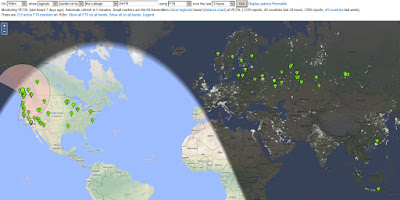 FT8 … Such A Tease
FT8 … Such A Tease
 |
| Looking towards EU over Georgia Strait, last winter |
With the continued tsunami of FT8 activity on the HF bands, I decided to have a look at what was happening in the FT8 segment of 160m.
On Saturday afternoon, about ninety minutes before my local sunset here in south west British Columbia, I set my receiver and 160m half-sloper to work, along with WSJT-X, on 1840kHz USB mode.
Although still in broad daylight, the waterfall was immediately flooded with signals! As I started to pay closer attention, I realized that many of the signals were from Europe! Many were audible while the rest were fast-approaching that level, being stronger than -20db. I let the receiver run for another few hours and took a screen capture of my PSK Reporter screen, illustrating what had been decoded over that time span:
 |
| courtesy: https://www.pskreporter.info/pskmap.html |
Checking other NW or VE7 monitors during the same time span showed no EU decodes at all, which I found surprising ... perhaps I missed someone. My location here on the eastern shoreline of Mayne Island looks towards EU and many other directions directly over a large body of saltwater ocean, Georgia Strait. The photo above was taken last winter, through the living room window. It is also very quiet, electrically, with little or no noise most of the time.
It appears that the lack of man-made noise combined with the theoretical 6db saltwater horizon gain (being realized), is enough to allow these signals to be heard. Signals continued to be decoded as darkness approached but at around 1800 local time, began to drop off ... evidently this appears to be a sunset enhancement, similar to what I often see to the east coast on the 630m band.
Now here’s where it gets even more interesting, as my decodes for the ninety minutes before and after local sunrise indicated a similar pattern!
The most probable path for these signals, around sunrise, would be via the long path in darkness. Although there is no saltwater directly behind me, it seems that the 'quietness' may be enough to do the job. Here’s the slightly post-sunrise screen cap from PSK Reporter:
 |
| courtesy: https://www.pskreporter.info/pskmap.html |
FT8 is surely a tempting seductress. So far I have resisted the fast-growing urge to spark-up in this mode on 160m ... but I may be growing weaker. This all looks so very interesting.













Using FT8 I worked 80 meter WAS in less than 2 weeks just being active a couple of hours each night. About the same success with 40 meters. Just needing West Virginia for my WAS on 40 meters. Watching for the grids in each state certainly makes things pretty efficient.
Steve, you’re slowly breaking down my resistance to FT8 by showing how it allows for activity during this period of slothful sun in unusual ways. As a dyed-in-the-wool CW operator, I still miss the idea of being in charge of the action and involved in a direct, one-to-one communication – even if it’s just a rubber stamp QSO. But I am beginning to understand your description of the seductive nature of this beast and may succumb one day.
I don’t want to get airy-fairy about this, but I miss the volition in FT8, the literally hands-on action and timing that CW demands, even in a “599” exchange with an SES station or DXpedition. (Not to mention battling against DQRM and morons who don’t notice – or know – that DX stations usually work split.) To me, FT8 still smacks of AI in a way I’m not ready to accept. But maybe I’m a dinosaur looking at mammals…and thinking: I can see they’re successful, but their way of life is not for me.
73,
Colin
Thanks for your interesting comments. I too prefer CW over any other mode but this mode seems to have taken a huge bite out of the normal CW action. Colin, apparently I am not as strong as I had hoped, and broke down. This afternoon I worked a number of Europeans on 160. It was interesting but not what I would call enjoyable. The challenge is to keep track of what’s all happening at break-neck speed and trying not to mess up or QRM others by transmitting outside of the proper sequence period. Hopefully I grew some new brain cells in the process 🙈